
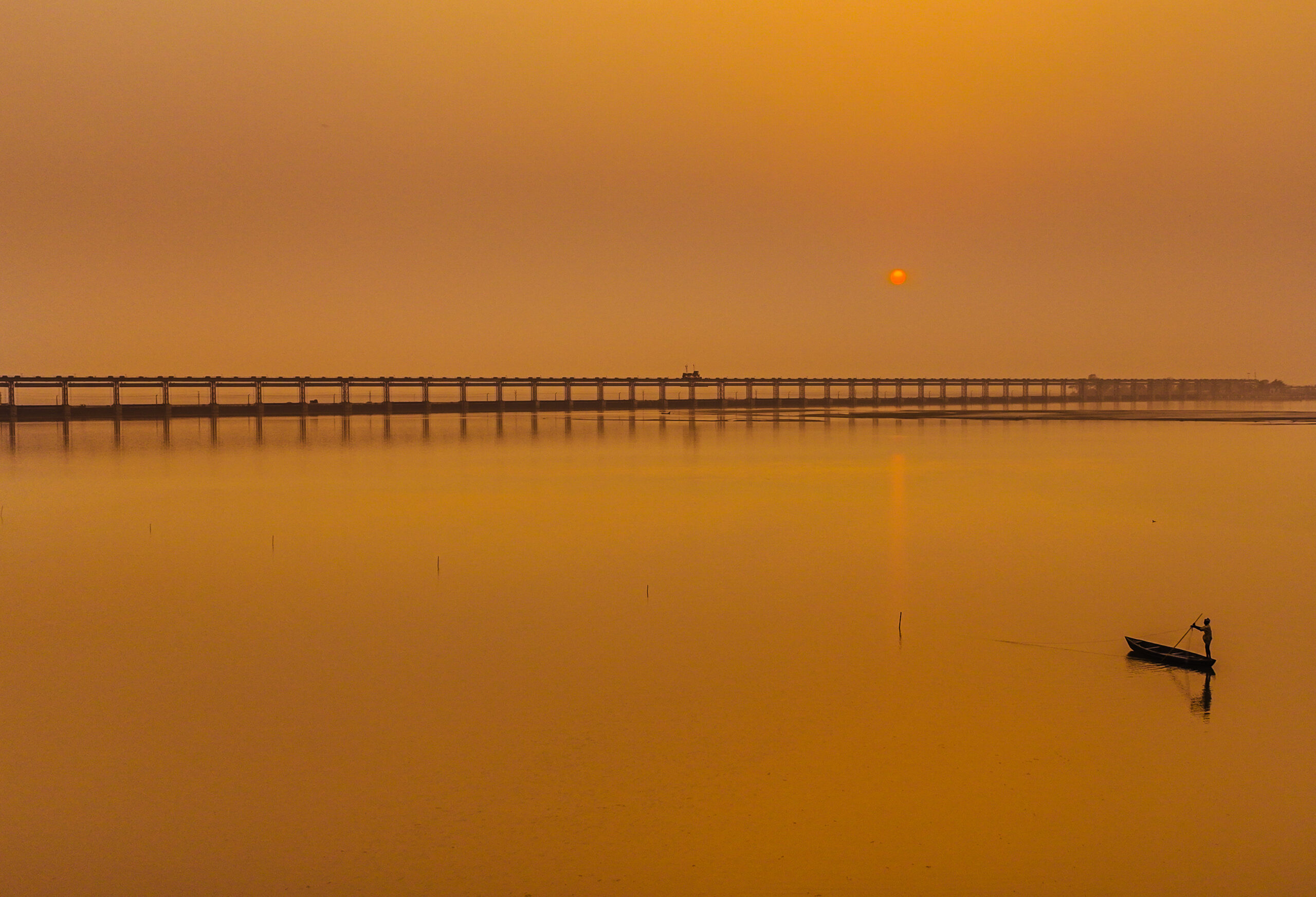
KATHMANDU: Nestled in the eastern region of Nepal, Sunsari District is a dynamic area, rich in cultural heritage, religious significance, and natural beauty. The district, located in Koshi Province, offers a fascinating blend of history, spirituality, agriculture, and unique wildlife, making it a captivating destination for travelers seeking both adventure and tranquility.
A Glimpse into Sunsari’s Geography and Demographics
Sunsari is bordered by India to the south, Morang District to the east, Dhankuta District to the north, and Udayapur District along the Saptakoshi River to the west. Its headquarters, Inaruwa, serves as a key hub for governance and development, while cities like Dharan and Itahari play a central role in the region’s social and economic landscape. Covering an area of 1,257 square kilometers, Sunsari is home to over 934,000 people, with a fairly balanced gender ratio, comprising 454,075 males and 480,386 females.
The region is predominantly part of Nepal’s Terai, a fertile plain that supports an agriculture-based economy. The locals grow rice, wheat, pulses, oilseeds, sugarcane, jute, and tobacco, contributing significantly to the district’s economic development. The elevation varies from 152 meters above sea level in the south to 914 meters in the north, creating a diverse range of landscapes that attract nature enthusiasts and photographers.
There are 12 local level government in Sunsari. These are:
Itahari Sub Metropolitan city
Dharan Sub Metropolitan city
Inaruwa Municipality
Duhabi Municipality
Ramdhuni Municipality
Barahakshetra Municipality
Dewanganj Rural Municipality
Koshi Rural Municipality
Gadhi Rural Municipality
Barju Rural Municipality
Bhokraha Narasingh Rural Municipality
Harinagar Rural Municipality
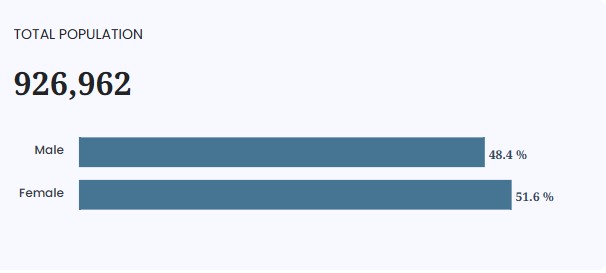
Total Population of Sunsari district. (Source: National Population and Housing Census 2021)
Itahari Sub Metropolitan City is a vibrant urban hub that blends rich cultural diversity, scenic landscapes, and a deep-rooted history. Known for its historical significance and natural beauty, Itahari offers a unique experience for travelers seeking a mix of tradition, adventure, and tranquility.
The name Itahari has an intriguing origin story tied to the indigenous Tharu community and the use of bricks (known as “Itta” in the local language) and wood (“Hari” in their dialect) in construction during the Rana era. It is believed that during the time of the Rana regime, a system for punishing criminals was developed using a structure made from bricks and wood. In the local Tharu language, bricks were referred to as “Itta,” and wood was called “Hari.” The merging of these two words gave birth to the name Itahari, reflecting the region’s connection with both its indigenous people and the practical use of natural materials in its early history.
Itahari is a hub of linguistic and cultural diversity. The most commonly spoken languages are Nepali, Tharu, Maithili, Rai, Limbu, Newari, Tamang, Sunuwar, and Hindi, creating a culturally rich environment. This diversity is not only reflected in language but also in the variety of religious practices, including Hinduism, Buddhism, Islam, Christianity, and Kirat, making Itahari a symbol of religious tolerance and harmony.
The city’s population is composed of several ethnic groups, including Brahmins, Kshetris, Newars, Rai, Limbu, Tharu, Gurung, Tamang, Muslims, Musahars, Sarkis, Damais, Kamis, and Sherpas. This ethnic diversity is reflected in the city’s festivals, customs, and way of life. Some of the major festivals celebrated in Itahari include Dashain and Tihar, the largest Hindu festivals in Nepal, celebrated with much joy and fervor; Teej, a festival dedicated to women, featuring fasting and prayers; Holi, the colorful festival marking the arrival of spring; Shree Krishna Janmashtami, celebrating Lord Krishna’s birth; Ram Navami, the celebration of Lord Ram’s birth; Id and Ramzan, major Islamic festivals observed by the local Muslim community; and Lhosar, celebrated by the indigenous Kirat and Tharu communities.
Itahari also hosts several fairs and cultural events such as Siruwa Mela (held at Kachana Mahadev in Itahari-4), Jitiya, Chauthi Chand, and the vibrant celebrations of Diwali (Sukhraati), Jatra, and Gothale. These festivals, marked by joyous celebrations and traditional rituals, provide a glimpse into the heart of the city’s cultural fabric.
Apart from its rich cultural diversity, Itahari is home to several tourist attractions that highlight the beauty of the region. One of the most picturesque spots is Talatalaiya, located at the boundary of Ward No. 2 and 3. This area, known for its natural beauty, provides a serene environment perfect for relaxation. Similarly, Kavyabatik in Ward No. 5 offers travelers an opportunity to immerse themselves in traditional Nepali art and architecture.
Another must-visit destination is Mechikali Pokhari, a natural pond situated within the Itahari Municipality. In the center of this pond is a unique structure called Sismahal, resembling a small palace. This place is known for its tranquil atmosphere and stunning natural beauty. For those looking for some recreational activities, boating and fishing are allowed at the pond, adding to its charm.
For those seeking spiritual solace, the Krishna Pranami Religious Forest, located along the Budhi Khola River, offers a peaceful retreat. This religious site, with its serene temple and surrounding forest, provides visitors with a place to reflect and connect with their inner selves.
Itahari is also home to several important temples that reflect its spiritual heritage. The Krishna Pranami Temple, Radhakrishna Shiva Temple, South Kali Temple, and Mankamana Temple are not only significant religious sites but also showcase the architectural beauty of the region.
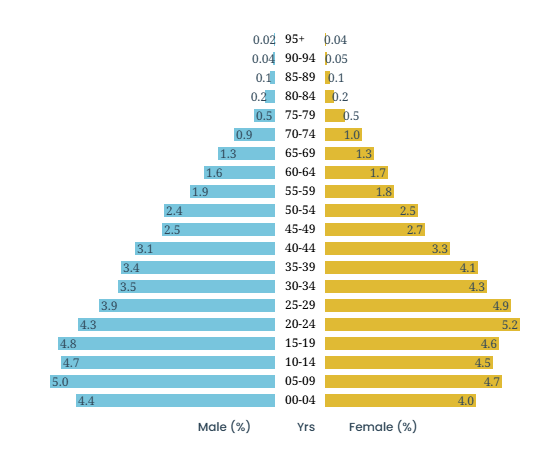
Total Population of Sunsari district. (Source: National Population and Housing Census 2021)
Dharan is a city rich in history, culture, and natural beauty. Located in the Sunsari District of the Koshi Province, Dharan is not only one of Nepal’s most beautiful cities but also a cultural melting pot that draws visitors from all over the world.
Dharan’s history is deeply rooted in the Mahabharata era and the ancient Kirat Kingdom, with Vijaypur (a prominent area in Dharan) once serving as the capital of the Kirat kingdom. The city’s history can be traced back to several mythological and historical events, such as the legend of Satidevi’s dental downfall and the Dantakali Temple’s association with ancient beliefs. Additionally, the Pindeswar Temple, which was renovated by a Bengal king 500 years ago, further solidifies Dharan’s importance in both religious and historical contexts. These sites, along with numerous ancient records, highlight Dharan’s rich cultural and archaeological heritage, making it a must-visit destination for history enthusiasts.
Dharan’s name is said to originate from the dense forests that once surrounded the area. According to local stories, the forests were cleared by woodcutters, known as Aravals, who used the trees for timber. The name “Dharan” is believed to be derived from the process of clearing these forests, which was known as “Dhara” or “Dharap.” Over time, this led to the establishment of the modern city of Dharan.
Historically, the area of Vijaypur has been inhabited for centuries, but the modern city began to take shape in the 1950s when the dense jungle was cleared to create a settlement. The city officially began its development in 1959, during the reign of the Rana Prime Minister Shri 3 Chandrasamsher, when he established Chandranagar (now the old market). In 1990, Prime Minister Shri 3 Juddha Samsher established Juddha Nagar (now New Bazaar). These early settlements laid the foundation for what Dharan is today.
The city saw significant growth after 1959 with the establishment of the British Gurkha Recruitment Center in Dharan, which further contributed to the population increase and economic activity. By 2010, Dharan became a bustling urban center.
Today, Dharan is a thriving city, known for its diverse population, vibrant cultural life, and its significant role in arts, literature, sports, and education. It has become an increasingly popular destination for visitors looking to explore Nepal’s cultural and historical diversity. The city is renowned for its beautiful landscapes, educational institutions, and healthcare facilities. Dharan’s development into a city that blends tradition with modernity has made it an emerging model municipality in the eastern region and a prime example of Nepal’s growth.
Visitors to Dharan can enjoy its rich cultural tapestry, with a mix of local customs, festivals, and religious traditions. The city celebrates various festivals, including Dashain, Tihar, Holi, and numerous indigenous festivals, showcasing its diversity.
Inaruwa Municipality, located in eastern Nepal, is a town steeped in history, culture, and religious significance, making it a hidden gem in the region. The area’s history dates back thousands of years, with dense jungles once covering the land. During the reign of Shri 3 Bhim Samsher, efforts to clear these forests began in order to promote agriculture. As the forest was cleared, locals discovered an ancient well, constructed with wooden planks, which would later become a symbol of the area’s heritage. The well became a hiding place for bandits from India, who would raid the area during the day and seek refuge there at night. Over time, this well was preserved as a historical relic, and locals began referring to the area as Inaruwa, derived from the well.
Today, Inaruwa is a thriving municipality, attracting both religious pilgrims and tourists from across the region. The area boasts an array of sacred sites and religious shrines, including numerous temples, mosques, and holy sites. The town’s spiritual offerings include temples dedicated to Hindu gods and goddesses, such as Shiva, Durga, Ram Janaki, and Radha Krishna, as well as several mosques for Islamic worshippers. These religious landmarks not only serve as places of devotion but also attract visitors who come to explore the rich cultural diversity that the town embodies.
Inaruwa’s religious heritage is further enriched by the variety of festivals and local celebrations held throughout the year, adding to the town’s vibrant cultural identity. The town’s scenic beauty, combined with its historical and spiritual significance, makes it a unique destination for those seeking a blend of cultural exploration and spiritual enlightenment. The well-preserved religious sites, including those dedicated to Bhagwati, Laxminarayan, Hanuman, and Kali, create a peaceful atmosphere that invites reflection and reverence.
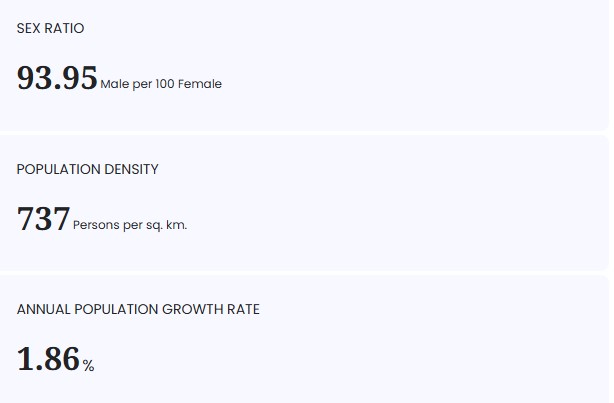
Sex ratio, population density, and annual population growth rate in Sunsari district. (Source National Population and Housing Census 2021)
The town’s religious sites, such as the Sitaghat and Babiya Pokhari, alongside its culturally rich atmosphere, provide an excellent opportunity for spiritual tourism. By promoting its unique offerings, Inaruwa can become an essential part of Nepal’s tourism industry, drawing visitors who seek to experience its tranquility, history, and diversity. Through thoughtful preservation and promotion of its cultural and religious heritage, Inaruwa can continue to thrive as a beautiful, meaningful destination for future generations.
Duhabi Municipality is located in the Sunsari district of Province No. 1, Nepal. The total area of this municipality is 76.67 square kilometers. According to the 2021 census, Duhabi Municipality has a population of 66,074, with 32,797 males and 33,277 females. Duhabi’s boundaries are as follows: to the east, it borders Budhiganga Rural Municipality of Morang District; to the west, it borders Gadhi Rural Municipality of Sunsari; to the north, it borders the Itahari Sub-Metropolitan City; and to the south, it borders Budhiganga Rural Municipality and Barju Rural Municipality.
Geographically, the municipality stretches in the shape of a banana leaf, lying between 87°12’27” to 87°17’54” East longitude and 26°29’15” to 26°37’11” North latitude. The municipality is divided into 12 wards, with the northern part being elevated and the southern part being comparatively lower. Small streams originating from the high northern region, such as the Budhi River, Tengra River, and Dhanushna River, flow southward. Though the municipality is not extremely diverse in terms of geography, the presence of small rivers and streams like the Budhi River and others creates local variations in the landscape.
Ramdhuni Municipality is located between Inaruwa Municipality and Itahari Sub-Metropolitan City. It is shaped roughly like a drum on the map. The municipality is situated at an altitude of 182 to 185 meters above sea level. The majority of the land in this municipality is used for agricultural purposes. The East-West Highway passes through the central part of the municipality.
According to legend, during the Treta Yuga, Lord Ram stayed overnight at this location while on his exile journey and lit a fire. When he left the place, it is believed that he left behind a pair of slippers. There is a local belief that Baba Vanskhadi, a yogi who meditated here, kept the fire that Lord Ram had lit burning, and he began distributing the ashes from the fire as prasad (holy offering). The tradition of offering prayers at the Ramdhuni Temple and receiving blessings from the ashes is still practiced, and people believe that their wishes are fulfilled by doing so.
Barrahakshetra Municipality is located in the northwestern part of Sunsari District, named after the famous religious site, the ancient Barahakshetra Temple, situated on the banks of the historic Kosiki River.
The municipality is bordered by Ramdhuni Municipality to the east, Dharan Sub-Municipality and Sanggurigadhi Rural Municipality of Dhankuta to the north, Bhokraha Narsingh Rural Municipality and Koshi Rural Municipality to the south, and Belka Municipality of Udaypur to the west.
Covering an area of 222.09 square kilometers, the preliminary population according to the 2021 census is approximately 92,000.
Dewanganj Rural Municipality is one of the 12 local levels in Sunsari District, located in the southern part of the district. The municipality is home to a diverse population, including various ethnic groups such as Mehta (Kushwaha), Yadav, Muslims, Gaderi, Musahar, Uraw, Dhanuk, Malah, Banter, Tatma, Paswan, Sudi, Tharu, Teli, Newar, among others, representing approximately 45 different communities. The municipality covers an area of 53.56 square kilometers and has a population of 39,367 according to the 2021 national census. Around 10 languages are spoken here, with Hinduism being the predominant religion, followed by Islam.
Geographically, Dewanganj Rural Municipality is bordered by Barju Rural Municipality to the east, Araria District of Bihar, India, to the south, Harinagar Rural Municipality to the north, and Gadhi Rural Municipality to the northeast. The municipality is situated 13 kilometers west of Biratnagar, the capital of Province No. 1.
Agriculture is the main livelihood for about 90% of the population. Despite the cultural diversity, the community maintains a strong sense of harmony, tolerance, mutual respect, and fraternity. With the local government’s focus on developing information technology and bringing significant changes to agriculture, Dewanganj Rural Municipality is set to emerge as an attractive destination for agricultural tourism in the near future.
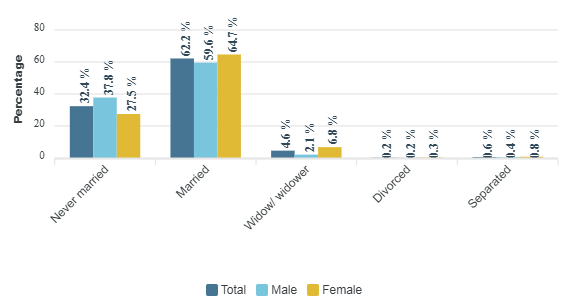
Marital status in Sunsari district. (Source: National Population and Housing Census 2021)
Koshi Rural Municipality is located in the southern part of Sunsari District. The total area of this municipality is 75.98 square kilometers. It is bordered by Bhokraha Rural Municipality to the east, the Saptari District to the west, Barahakshetra Municipality to the north, and India to the south.
According to the 2021 national census, Koshi Rural Municipality has a total of 9,169 households and a population of 48,804, with 24,358 males and 24,446 females.
Gadhi Rural Municipality is located in Sunsari District. The municipality has a total of 7,657 households and a population of 35,737. It lies about 18 kilometers south of the district headquarters, Inaruwa, and spans an area of 67.7 square kilometers. The municipality is bordered by Duhabi Municipality to the east, Harinagar Rural Municipality to the west, Itahari Sub-Metropolitan City and Inaruwa Municipality to the north, and Devanganj and Barju Rural Municipalities to the south.
The altitude of Gadhi Rural Municipality ranges from 152 meters to 914 meters above sea level. It is named after the famous Gadhi Temple. As part of the Terai region, the topography of the municipality is predominantly flat. The area is rich in fertile, cultivable land suitable for agriculture. Generally, the soil in this region is sandy in nature.
Barju Rural Municipality is located approximately 28 kilometers south of the district headquarters, Inaruwa, in Sunsari District. It is bordered by Biratnagar Metropolitan City in Morang District to the east, Devanganj Rural Municipality in Sunsari District to the west, India to the south, and Gadhi Rural Municipality and Duhabi Municipality to the north.
Covering an area of 69.43 square kilometers, Barju Rural Municipality occupies 5.44% of the total area of Sunsari District, which is 1,275 square kilometers.
Situated in the Terai region, the municipality consists mainly of flat land, which is suitable for habitation and agriculture. The area is predominantly characterized by fertile and cultivable land, with sandy soil commonly found in the region.
Bhokraha Narasingh Rural Municipality is located in the southwestern part of Sunsari District. It is bordered by Inaruwa Municipality to the east, Koshi Rural Municipality and India to the west, Barah Municipality to the north, and Harinagar Rural Municipality to the south. The East-West Highway runs through the central part of the municipality. Bhokraha Narasingh is known for its fertile land.
Situated near the Sapta Koshi River, this municipality is considered significant for its underground water resources. It is also well-known in the district for its production of vegetables and fruits. The municipality holds historical and cultural importance due to its proximity to religious and historical sites such as Ramdhuni, Chhatra, Prakashpur, Chakraghatti, and Barahakshetra.
In ancient times, much of the land in Bhokraha Narasingh Rural Municipality was covered by dense forests. Along the banks of the Koshi River, small settlements of various ethnic groups could be found. Due to the dense forests, people had to settle along the riverbanks or at the foot of the hills. The remains of ancient settlements occasionally found in the area suggest this historical context.

The average age of first marriage in Sunsari district. (Source: National Population and Housing Census 2021)
Harinagar Rural Municipality is located in the eastern Terai region of Sunsari District, within the Province No. 1 of Nepal, as per the constitution of Nepal. The municipality covers a total area of 52.29 square kilometers in the flat terrain of the Terai region. It is bordered by Gadhi Rural Municipality and Devanganj Rural Municipality to the east, India to the west, Inaruwa Municipality and Bhokraha Narasingh Rural Municipality to the north, and India and Devanganj Rural Municipality to the south.
For administrative purposes, Harinagar Rural Municipality is divided into 7 wards based on geography and population.
The population of this municipality consists of diverse ethnic groups, including Muslims, Jhagad, Yadav, Koiris, Nuniya, Bhagat/Kalwar, Baniya, Kayastha, Sahu/Teli, Haluwai, Lohar, Malah, Dhanuk, Khatwe, Tatma, Mochi (Chamar), Sada (Musahar), Bhujel, and Newar. Among these, the Jhagad community, who speak one of the world’s endangered Dravidian languages, resides in this municipality.
A Cultural Mosaic
Sunsari District stands as a prime example of Nepal’s cultural diversity, home to a multi-religious, multi-ethnic, and multi-lingual population. According to the National Census of 2021, the district has 116 ethnic groups, with Muslims and Tharus being the largest communities. The 76 different mother tongues spoken in the area reflect the region’s rich cultural tapestry. Nepali, Maithili, Tharu, and Urdu are the most widely spoken languages.
The district celebrates a variety of festivals that showcase its diverse cultural and religious heritage. Major festivals like Tihar, Chhath, Dashain, Fagu Purnima, Eid, Maghi, Undauli, Ubhauli, and Lhosar are celebrated with much enthusiasm. Each festival is marked with vibrant rituals, traditional dances, music, and family gatherings that offer visitors a chance to experience the warmth and hospitality of the people. The Siruwa festival, which begins in the month of Baisakh (April-May), and the local fairs that accompany these festivals, also draw significant attention. These fairs are often accompanied by public holidays, making them an excellent opportunity for visitors to immerse themselves in the local culture.
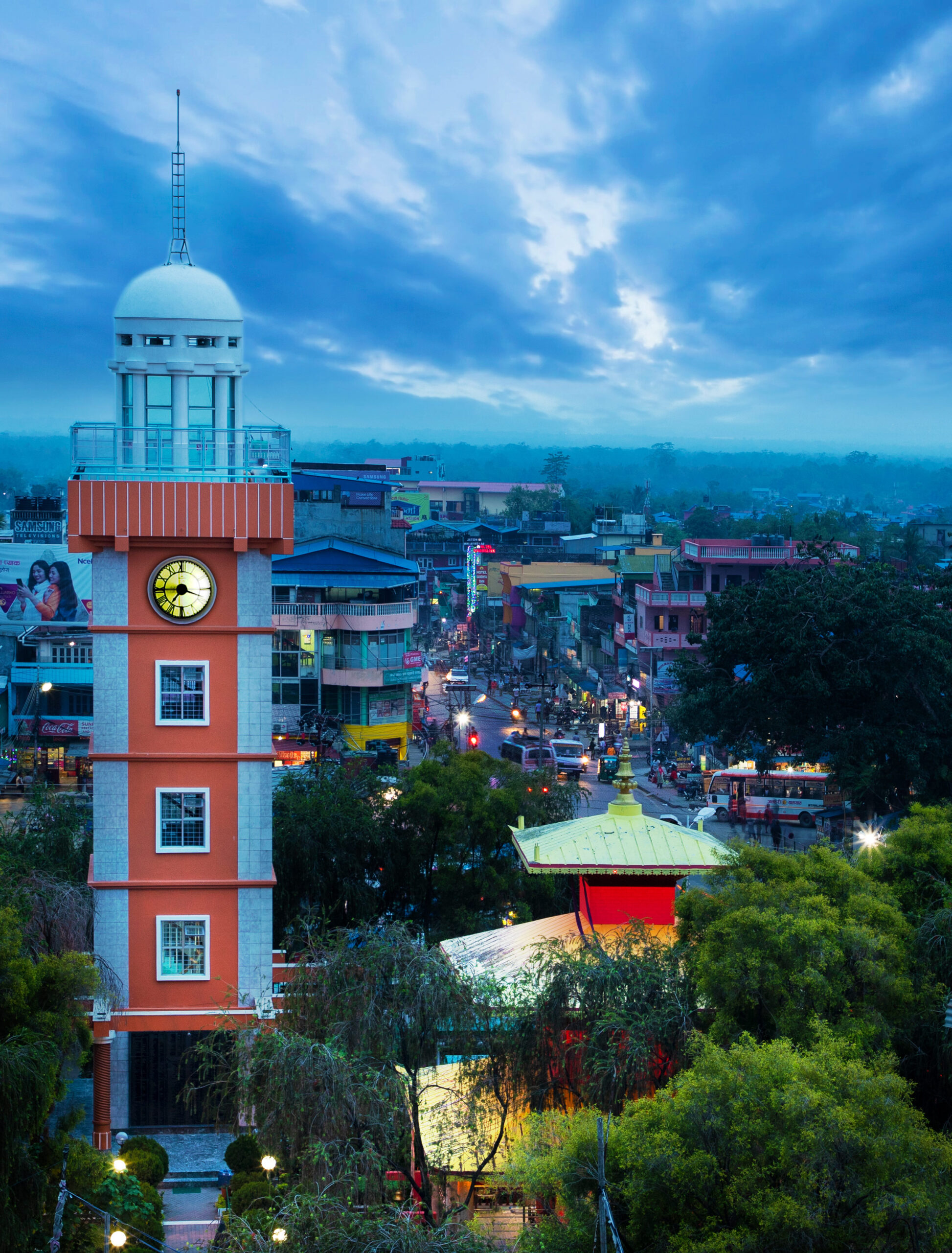
Dharan Clock Tower (Source: Wikimedia Commons)
One of the highlights for tourists visiting Sunsari is the spiritual and religious sites that dot the landscape. During particular times of the year, special gatherings take place at sacred places, such as the Koshi Riverbank during Mangsir Full Moon, Barahkshetra during Bala Chaturdashi and Shivaratri, and Pindeshwor in Dharan during the month of Shrawan. The fair held during Ram Navami at Ramdhuni is especially significant for both Hindu and non-Hindu communities, offering a unique experience for travelers to observe local customs and practices.
Religious Sites and Pilgrimage Destinations
Sunsari is dotted with sacred religious sites that are of great significance to Hindus, Buddhists, and Muslims alike. Among the most prominent is Pindeshwor Baba Dham, located in the Rudraksha Forest in the Vijaypur area of Dharan. According to myth, during the churning of the ocean (Samudra Manthan), the nectar (amrit) that emerged from the ocean was shaped into a round pind, which was then placed at this site as a Shivling. The legend adds a layer of mysticism to this sacred site, making it a revered destination for those who seek spiritual solace.
Barahkshetra is another important pilgrimage site in Sunsari, particularly for Hindus. According to religious texts, Lord Vishnu took the form of a gigantic boar (Varaha) to rescue the Earth from the demon Hiranyaksha, who had submerged it into the depths of the ocean. The site where the rivers Koka and Kaushiki converge is believed to be the location where Lord Vishnu restored balance to the universe. The temple at Barahkshetra is a significant place for Hindu devotees, attracting pilgrims from all over the country.
Additionally, the Budhasubba Temple in Vijaypur holds immense cultural and spiritual importance. It was established by King Lohang Sen of the Sen dynasty and is dedicated to the worship of the deity Budhasubba. The temple is associated with several local legends and myths, and it is believed to be the site where the tomb of the former Devwan Mori Hang was located. The annual fair held during the full moon of Baisakh at Budhasubba attracts thousands of visitors, where locals offer sacrifices and perform rituals to honor the deity.
For Buddhists, the Himalayan Mahayana Rinchen Gompa in Dharan is a key religious site. The serene ambiance and beautiful architecture make it a peaceful retreat for travelers interested in learning about Buddhist culture and practices.
Kumbh Mela: A Spiritual Extravaganza
One of the most significant spiritual events in Sunsari is the Kumbh Mela held at Barahkshetra. According to myth, when Jayanta, the son of Lord Indra, was fleeing with the pot of nectar (amrit) obtained from the churning of the ocean, drops of the nectar fell at various locations in India, leading to the establishment of grand Kumbh Mela festivals. The Kumbh Mela at Barahkshetra is considered one of the most significant in Nepal. The first Kumbh Mela was held in 2002 AD, and it has since become a biennial event, attracting millions of devotees. The second Kumbh Mela, held in 2014 AD, saw around 5 million participants. This massive gathering is not just a religious event but also a cultural celebration, making it an essential experience for those visiting Sunsari during the festival.
Nature and Wildlife: Koshi Tappu Wildlife Reserve

Wild water buffalo at Koshi Tappu Wildlife Reserve (Source: Wikimedia Commons)
Beyond its spiritual and cultural allure, Sunsari is home to one of Nepal’s most renowned wildlife conservation areas, the Koshi Tappu Wildlife Reserve. Established in 1976, the reserve was created to protect the endangered wild buffalo (Arna) and has since become a crucial habitat for a diverse range of wildlife species. The core area of the reserve spans 176 square kilometers, with an additional buffer zone of 173.5 square kilometers. In 1987, it was designated as a Ramsar site, recognizing its international importance as a wetland.
The reserve is not only home to the wild buffalo but also serves as a haven for over 450 species of birds, making it a prime location for birdwatching enthusiasts. Visitors can explore the reserve’s natural beauty, which includes lush forests, marshlands, and rivers, while observing the abundant wildlife that inhabits the area. The reserve spans across three districts: Sunsari, Saptari, and Udayapur, offering ample opportunities for eco-tourism and wildlife photography.
Sunsari is a place where history, culture, religion, and nature come together to offer an unparalleled experience. From the rich spiritual sites like Pindeshwor and Barahkshetra to the serene beauty of the Koshi Tappu Wildlife Reserve, this district has something for every traveler. Whether you are a history buff, nature enthusiast, or a spiritual seeker, Sunsari promises a journey that will leave you enriched, informed, and inspired.